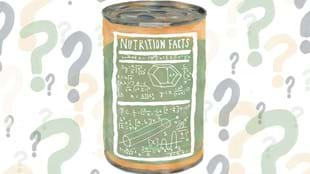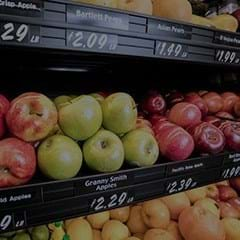What should I look for on a label?
Product labels have information on fat, saturates (or saturated fat, the “bad cholesterol raising” fat), carbohydrates, sugars, protein and salt content. As with calorie counts, they’re usually listed per 100 grams (or, if it’s a liquid, per 100 milliliters) and sometimes by portion. Ingredients are listed in order of weight, so the main ingredients in the packaged food come first. If the first few ingredients are cream, butter or oil, then the food is high in saturated fats. Sugar comes in many different guises (glucose, sucrose, maltose, corn syrup, etc) and if any of them are listed near beginning of the ingredient list it suggests the product is high in sugar.
What is meant by “energy”?
This is worth paying attention to if you’re trying to lose weight, or not put it on. It’s usually listed in kcals, which is short for “kilocalories”, which is another word for calories. It might also be listed in kJs, short for “kilojoules”, the metric measurement of calories. To find the energy content in kilojoules, multiply the calorie figure by 4.2. To find the energy content in calories divide the kilojoules figure by 4.2. The label will usually tell you how many calories are contained in 100 grams or 100 milliliters of the food or drink, so you can compare and contrast the calorie content of different products. Many products also state the calories in “one portion” of the food, although the manufacturer’s idea of a portion may be different from your idea of a portion and quite likely considerably smaller.
So, what does the average person need in their diet?
As a rough guide, the average man needs 2500kcal (10,500kJ) to maintain his weight, and the average woman needs 2000kcal (8,400kJ), but this will also depend on other factors, such your height, age and how much exercise you’re getting.
Making sense of food labels also depends on knowing a bit about the guidelines for recommended daily intakes of fat, saturates, sugar and salt. Some food products include reference intakes (sometimes called daily intakes or recommended intakes) in the labeling. They aren’t targets, but a useful guide.
Unless stated otherwise, these values are based on an average-sized woman doing an average amount of physical activity:
Energy: 8,400 kJ/2000kcal
Total fat: 70g
Saturates: 20g
Carbohydrates: 260g
Total sugars: 90g
Total fats: 90g
Protein: 50g
Salt: 6g
What if I don’t have time to stand around in the supermarket working all this out?
Try using the following guidelines on whether a food is high or low (or somewhere in between) in fat, saturated fat, sugar and salt.
Total fat
High: more than 17.5g of fat per 100g
Low: 3g of fat or less per 100g
Saturated fat
High: more than 5g of saturated fat per 100g
Low: 1.5g of saturated fat or less per 100g
Sugars, sometimes listed as "Carbohydrates (of which sugars)"
High: more than 22.5g of total sugars per 100g
Low: 5g of total sugars or less per 100g
Salt
High: more than 1.5g of salt per 100g (or 0.6g sodium)
Low: 0.3g of salt or less per 100g (or 0.1g sodium)
What about all those “lite”, “reduced salt”, “less fat”, “no added sugar” claims?
There are plenty of tricks of the food labeling trade, so don’t believe everything you read, particularly claims on the front of a packet. Words like “light” or “lite” should be taken with a grain of salt (or sodium). Quite often foods described as “light” or “lite” might be lower in fat than other products produced by the same brand, but higher in fat than other similar products, so still high in fat. Or they might be low in fat and high in sugar, so not necessarily healthy and still fattening. Similarly, a product that is promoted, as having “reduced salt” doesn’t mean a product is actually low in salt – it depends on the point of comparison, which is often unclear. And just because a product “contains no added sugar” (often used to promote fruit juice), this doesn’t mean the sugar content is low.
Can I take words such as “healthy” and “natural” at face value?
Be suspicious. These ill-defined words have no legal or formal meaning, and so manufacturers can get away with using them without being accused of breaching advertising or labeling regulations.
What about health benefit claims?
Look at the small print, particularly qualifiers that follow statements about a specific health benefit, such as the product that will “help to reduce digestive discomfort”. If you read the small print, it might say that this can reduce digestive comfort “as part of a balanced diet and healthy lifestyle”. Subtext: if you have balanced and healthy lifestyle you probably don’t need it.
What does gluten free really mean?
This varies from country to country, but generally only foods that contain 20 ppm (parts per million, sometimes labeled as mg/kg) or less can be labeled ‘gluten-free’. The term can be used on specialist substitute gluten-free products like breads, flours and crackers, which may contain gluten-free wheat starch.
Products that are naturally gluten-free can also be labeled as such, which has helped clear up confusion around gluten-free grains such as amaranth, buckwheat, quinoa, millet, and sorghum.
Yet the gluten-free label is also used on products that don’t contain gluten and which you probably wouldn’t have thought to have contained gluten in the first place, like tinned tomatoes and spring water. Some argue that this is the food industry exploiting the “gluten-free” trend to make their products sound healthier than they are, a redundant form of labeling that creates more confusion than clarity.
Can I still use something past its “best before” date?
This can get confusing, as there’s a difference between how long food can be kept before it begins to deteriorate, and how long food can be kept before it becomes unsafe to eat. There are two types of date marking: “use by” or “expires on” dates, and “best before” dates. Food that that has passed the “use by” or “expires on” date shouldn’t be eaten and can’t be legally sold, as they can pose a health or safety risk. Food that has passed the “best before” date is likely to be past its best in terms of texture taste and appearance, but is probably still safe to eat.
It’s all so confusing, isn’t there a simple rule?
Yes, try to avoid or cut down on processed foods that come with complicated labeling. If manufacturers don’t want us to easily identify what’s in a product, they probably have something to hide.







